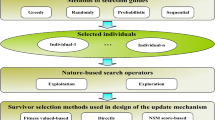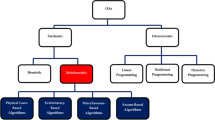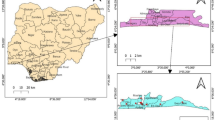Abstract
Meta-heuristic optimization algorithms are the new gate in solving most of the complicated nonlinear systems. So, improving their robustness, reliability, and convergence speed is the main target to meet the requirements of various optimization problems. In the current work, three different fractional-order chaos maps (FC-maps), which have been introduced recently, are incorporated with the fundamental flower pollination algorithm to tune its parameters adaptively. These maps are fractional logistic map, fractional sine map, fractional tent map, and their integer-order versions. As a result, fractional chaotic FPA (FC-FPA) is proposed. The FC-FPA has been mathematically tested over 10-, 30-, 50-, and 100-dimensional CEC 2017 benchmark functions. Moreover, the influence of merging FC-maps with FPA is investigated in case of increasing the number of maximum evaluation functions based on the ten functions of CEC 2020. Additionally, to assess the superiority of the proposed FC-FPA algorithm for more complicated optimization problems, it has been tested to extract the parameters of different chaotic systems with and without added noise. In addition, it is tested on the identification of the corresponding parameters for the chaotic behavior in brush-less DC motor. The results of the fractional version of CFPA are compared with that of integer CFPA and standard FPA via an extensive statistical analysis. Furthermore, a nonparametric statistical test is employed to affirm the superiority of the proposed fractional variants of CFPA. It is evident that the performance of FPA is highly influenced by integrating the fractional-order chaos maps as the introduced FC-FPA variants provide a better accurate and more consistent results as well as a higher speed of convergence especially upon using the fractional sine map.












Similar content being viewed by others
References
Abdeljawad T (2011) On riemann and caputo fractional differences. Comput Math Appl 62(3):1602–1611 (special issue on advances in fractional differential equations II)
Abdeljawad T, Baleanu D (2016) Discrete fractional differences with nonsingular discrete Mittag–Leffler kernels. Adv Differ Equ 2016(1):232
Abdeljawad T, Baleanu D (2017) Monotonicity analysis of a nabla discrete fractional operator with discrete Mittag–Leffler kernel. Chaos Solitons Fractals 102:106–110
Abdeljawad T, Baleanu D (2017) On fractional derivatives with exponential kernel and their discrete versions. Rep Math Phys 80(1):11–27
Alatas B (2010) Chaotic bee colony algorithms for global numerical optimization. Expert Syst Appl 37(8):5682–5687
Alatas B, Akin E, Ozer AB (2009) Chaos embedded particle swarm optimization algorithms. Chaos Solitons Fractals 40(4):1715–1734
Arora S, Anand P (2018) Chaotic grasshopper optimization algorithm for global optimization. Neural Comput Appl 31:1–21
Atici F, Eloe P (2009) Initial value problems in discrete fractional calculus. Proc Am Math Soc 137(3):981–989
Atici FM, Eloe PW (2007) A transform method in discrete fractional calculus. Int J Differ Equ 2(2):165–176
Atıcı FM, Şengül S (2010) Modeling with fractional difference equations. J Math Anal Appl 369(1):1–9
Brest J, Greiner S, Boskovic B, Mernik M, Zumer V (2006) Self-adapting control parameters in differential evolution: a comparative study on numerical benchmark problems. IEEE Trans Evol Comput 10(6):646–657
Bo A, Yue P, Price KV, Awar NH (2020) Problem definitions and evaluation criteria for the CEC 2020 special session and competition on single objective bound constrained numerical optimization. National University of Defense Technology, Changsha, Hunan, PR China and Kyungpook National University, Daegu, South Korea and Nanyang Technological University, Singapore, technical report
Chirikov BV (1979) A universal instability of many-dimensional oscillator systems. Phys Rep 52(5):263–379
Civicioglu P (2013) Backtracking search optimization algorithm for numerical optimization problems. Appl Math Comput 219(15):8121–8144
Civicioglu P, Besdok E (2018) A+ evolutionary search algorithm and QR decomposition based rotation invariant crossover operator. Expert Syst Appl 103:49–62
Civicioglu P, Besdok E (2019) Bernstain-search differential evolution algorithm for numerical function optimization. Expert Syst Appl 138:112831
Derrac J, García S, Molina D, Herrera F (2011) A practical tutorial on the use of nonparametric statistical tests as a methodology for comparing evolutionary and swarm intelligence algorithms. Swarm Evol Comput 1(1):3–18
Derrac J, García S, Molina D, Herrera F (2011) A practical tutorial on the use of nonparametric statistical tests as a methodology for comparing evolutionary and swarm intelligence algorithms. Swarm Evol Comput 1(1):3–18
Deshpande A, Daftardar-Gejji V (2016) Chaos in discrete fractional difference equations. Pramana 87(4):49
Gibbons JD, Chakraborti S (2011) Nonparametric statistical inference. In: Lovric M (ed) International encyclopedia of statistical science. Springer, New York, pp 977–979
Ji Y, Lai L, Zhong S, Zhang L (2018) Bifurcation and chaos of a new discrete fractional-order logistic map. Commun Nonlinear Sci Numer Simul 57:352–358
Kamalapathi K, Priyadarshi N, Padmanaban S, Holm-Nielsen J, Azam F, Umayal C, Ramachandaramurthy V (2018) A hybrid moth-flame fuzzy logic controller based integrated CUK converter fed brushless DC motor for power factor correction. Electronics 7(11):288
Kohli M, Arora S (2018) Chaotic grey wolf optimization algorithm for constrained optimization problems. J Comput Des Eng 5(4):458–472
Kumar Y, Singh PK (2019) A chaotic teaching learning based optimization algorithm for clustering problems. Appl Intell 49(3):1036–1062
Lorenz EN (1963) Deterministic nonperiodic flow. J Atmos Sci 20(2):130–141
Luo S, Li S, Tajaddodianfar F, Hu J (2018) Anti-oscillation and chaos control of the fractional-order brushless DC motor system via adaptive echo state networks. J Frankl Inst 355(14):6435–6453
May RM (1976) Simple mathematical models with very complicated dynamics. Nature 261(5560):459
Mirjalili S, Gandomi AH (2017) Chaotic gravitational constants for the gravitational search algorithm. Appl Soft Comput 53:407–419
Rizk-Allah RM, Hassanien AE, Bhattacharyya S (2018) Chaotic crow search algorithm for fractional optimization problems. Appl Soft Comput 71:1161–1175
Rössler OE (1976) An equation for continuous chaos. Phys Lett A 57(5):397–398
Sun L (2017) A new method for sensorless control of brushless DC motor. Clust Comput 22:1–8
Wang Y, Cai Z, Zhang Q (2011) Differential evolution with composite trial vector generation strategies and control parameters. IEEE Trans Evol Comput 15(1):55–66
Wang Y, Li H-X, Huang T, Li L (2014) Differential evolution based on covariance matrix learning and bimodal distribution parameter setting. Appl Soft Comput 18:232–247
Wu G, Mallipeddi R, Suganthan P (2017) Problem definitions and evaluation criteria for the CEC 2017 competition on constrained real-parameter optimization. National University of Defense Technology, Changsha, Hunan, PR China and Kyungpook National University, Daegu, South Korea and Nanyang Technological University, Singapore, technical report
Wu G-C, Baleanu D (2014) Discrete fractional logistic map and its chaos. Nonlinear Dyn 75(1–2):283–287
Wu G-C, Baleanu D (2015) Discrete chaos in fractional delayed logistic maps. Nonlinear Dyn 80(4):1697–1703
Wu G-C, Baleanu D, Zeng S-D (2014) Discrete chaos in fractional sine and standard maps. Phys Lett A 378(5–6):484–487
Xu S, Wang Y, Liu X (2017) Parameter estimation for chaotic systems via a hybrid flower pollination algorithm. Neural Comput Appl 30:1–17
Yang X-S (2012) Flower pollination algorithm for global optimization. In: Stepney S, Verlan S (eds) Unconventional computation and natural computation. Springer, New York, pp 240–249
Yang X-S, Deb S (2009) Cuckoo search via lévy flights. In: 2009 world congress on nature & biologically inspired computing (NaBIC). IEEE, pp 210–214
Yousri D, AbdelAty AM, Said LA, Elwakil AS, Maundy B, Radwan AG (2019) Chaotic flower pollination and grey wolf algorithms for parameter extraction of bio-impedance models. Appl Soft Comput 75:750–774
Yousri D, Allam D, Eteiba M (2018) Chaotic whale optimizer variants for parameters estimation of the chaotic behavior in permanent magnet synchronous motor. Appl Soft Comput 74:479–503
Yousri D, Allam D, Eteiba M, Suganthan PN (2019) Static and dynamic photovoltaic models’ parameters identification using chaotic heterogeneous comprehensive learning particle swarm optimizer variants. Energy Convers Manag 182:546–563
Yousri D, Babu TS, Allam D, Ramachandaramurthy VK, Etiba MB (2019) A novel chaotic flower pollination algorithm for global maximum power point tracking for photovoltaic system under partial shading conditions. IEEE Access 7:121432–121445
Zhang J, Sanderson AC (2009) JADE: adaptive differential evolution with optional external archive. IEEE Trans Evol Comput 13(5):945–958
Zhou Y, Zhao K, Liu D (2016) Chaotic dynamic analysis of brushless DC motor. J Math Inf 5:39–43
Author information
Authors and Affiliations
Corresponding author
Ethics declarations
Conflict of interest
The authors declare that they have no conflict of interest concerning the publication of this manuscript.
Additional information
Publisher's Note
Springer Nature remains neutral with regard to jurisdictional claims in published maps and institutional affiliations.
Rights and permissions
About this article
Cite this article
Yousri, D., Allam, D., Babu, T.S. et al. Fractional chaos maps with flower pollination algorithm for chaotic systems’ parameters identification. Neural Comput & Applic 32, 16291–16327 (2020). https://doi.org/10.1007/s00521-020-04906-7
Received:
Accepted:
Published:
Issue Date:
DOI: https://doi.org/10.1007/s00521-020-04906-7




